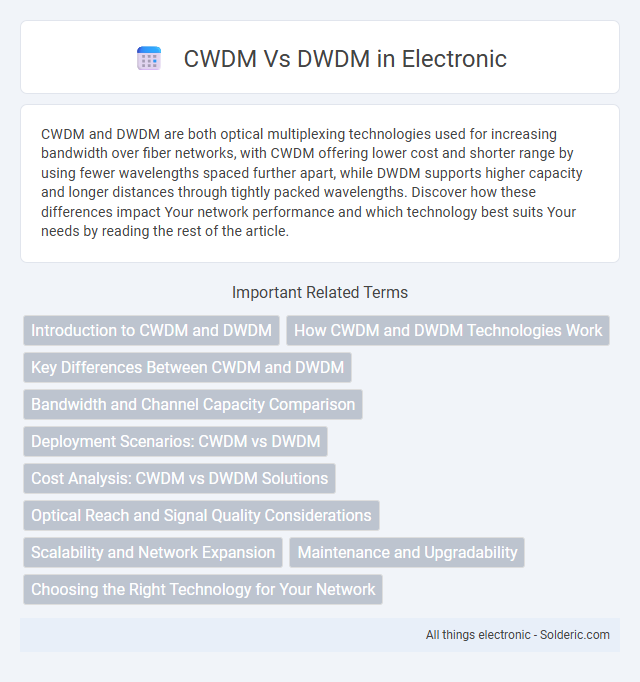CWDM and DWDM are both optical multiplexing technologies used for increasing bandwidth over fiber networks, with CWDM offering lower cost and shorter range by using fewer wavelengths spaced further apart, while DWDM supports higher capacity and longer distances through tightly packed wavelengths. Discover how these differences impact Your network performance and which technology best suits Your needs by reading the rest of the article.
Comparison Table
| Feature | CWDM (Coarse Wavelength Division Multiplexing) | DWDM (Dense Wavelength Division Multiplexing) |
|---|---|---|
| Channel Spacing | 20 nm | 0.8-1.6 nm |
| Number of Channels | 8 to 18 | 40 to 160+ |
| Transmission Distance | Up to 80 km | Up to 2000+ km |
| Cost | Lower | Higher |
| Equipment Complexity | Simple | Complex |
| Use Case | Metro and Access Networks | Long-haul Telecommunication Networks |
| Optical Amplifiers | Rarely used | Required for long distances |
| Data Rate Support | Lower aggregate bandwidth | Higher aggregate bandwidth |
Introduction to CWDM and DWDM
CWDM (Coarse Wavelength Division Multiplexing) and DWDM (Dense Wavelength Division Multiplexing) are advanced fiber optic technologies designed to increase bandwidth by transmitting multiple data streams simultaneously over a single optical fiber. CWDM uses wider channel spacing with up to 18 wavelengths typically spaced 20 nm apart, making it cost-effective for metropolitan and access networks. DWDM offers closer channel spacing of 0.8 nm to 1.6 nm, supporting up to 80 or more wavelengths, ideal for long-haul and high-capacity backbone networks, enabling your infrastructure to handle large volumes of data efficiently.
How CWDM and DWDM Technologies Work
CWDM (Coarse Wavelength Division Multiplexing) and DWDM (Dense Wavelength Division Multiplexing) both enable the transmission of multiple data streams over a single optical fiber by using different wavelengths of light. CWDM separates channels with wider spacing (typically 20 nm), allowing fewer channels and lower costs but shorter transmission distances due to higher signal loss. DWDM uses narrower wavelength spacing (around 0.8 nm), supporting more channels with higher capacity and longer transmission distances, making it ideal for large-scale telecom networks and data centers.
Key Differences Between CWDM and DWDM
CWDM (Coarse Wavelength Division Multiplexing) and DWDM (Dense Wavelength Division Multiplexing) differ primarily in channel spacing, with CWDM typically spaced at 20 nm intervals and supporting up to 18 channels, while DWDM uses narrower spacing of 0.8 nm or less to accommodate up to 80 or more channels. CWDM is cost-effective for shorter distances and lower bandwidth requirements, operating over distances up to 80 km, whereas DWDM suits long-haul telecommunications and data center interconnects, supporting distances beyond 1000 km with higher data rates. The optical components for DWDM are more complex and expensive due to precise wavelength control, contrasting with CWDM's simpler, more affordable design optimized for metro networks and enterprise applications.
Bandwidth and Channel Capacity Comparison
CWDM offers up to 18 channels with channel spacing of 20 nm, supporting lower bandwidth applications and shorter distances. DWDM provides over 80 channels with tightly spaced wavelengths at 0.8 nm or less, enabling significantly higher bandwidth and greater channel capacity for long-haul and high-demand networks. Your choice depends on the required data throughput and scalability, with DWDM favored for dense, high-capacity optical fiber environments.
Deployment Scenarios: CWDM vs DWDM
CWDM (Coarse Wavelength Division Multiplexing) is ideal for short to medium distance deployments, such as campus networks or metropolitan area networks (MANs), where cost-effective bandwidth expansion is needed without extensive infrastructure. DWDM (Dense Wavelength Division Multiplexing) suits long-haul and high-capacity deployments, like data center interconnects or telecommunications backbone networks, offering higher spectral efficiency and greater channel density. Your choice between CWDM and DWDM depends on factors like required transmission distance, bandwidth capacity, and budget constraints.
Cost Analysis: CWDM vs DWDM Solutions
CWDM (Coarse Wavelength Division Multiplexing) offers a lower-cost solution with simpler infrastructure and fewer components, making it ideal for shorter distance applications with moderate channel capacity. DWDM (Dense Wavelength Division Multiplexing) involves higher initial investment due to complex transceivers and advanced multiplexing equipment, but it delivers greater bandwidth and scalability for long-haul and high-capacity networks. Budget considerations often favor CWDM for cost-effective metro networks, whereas DWDM is preferred where performance and future-proofing justify the higher expenditure.
Optical Reach and Signal Quality Considerations
CWDM offers shorter optical reach typically up to 80 kilometers due to wider channel spacing, which reduces signal interference but limits scalability. DWDM supports longer optical reach exceeding 100 kilometers, using tighter channel spacing and advanced amplification technologies to maintain superior signal quality over extended distances. Your network choice should balance distance requirements with signal integrity, where DWDM excels in high-capacity, long-haul deployments and CWDM suits cost-effective, shorter-range connections.
Scalability and Network Expansion
CWDM offers cost-effective scalability for short to medium-distance networks by supporting fewer channels with wider spacing, making it ideal for smaller-scale network expansion. DWDM provides higher scalability and capacity through dense channel spacing, enabling your network to support hundreds of wavelengths for long-haul and metro applications, making it suitable for extensive network growth. Choosing DWDM ensures robust future-proofing for large-scale network expansion with greater bandwidth and reach.
Maintenance and Upgradability
CWDM systems offer simpler maintenance and easier upgrades due to fewer channels and lower cost components, making them suitable for shorter-distance networks with moderate bandwidth needs. DWDM provides higher capacity and better scalability, enabling seamless integration of new wavelengths without disrupting existing services, ideal for long-haul and high-bandwidth applications. Your choice between CWDM and DWDM will impact future network expansion, operational complexity, and maintenance overhead.
Choosing the Right Technology for Your Network
CWDM offers cost-effective solutions for metropolitan and enterprise networks with shorter distances and lower channel counts, making it ideal for budget-conscious deployments. DWDM supports higher capacity and longer distances with dense channel spacing, suitable for large-scale data centers and carrier-grade backbone networks requiring massive bandwidth. Evaluating network scale, budget, and future scalability helps determine whether CWDM's simplicity or DWDM's advanced performance best meets your infrastructure needs.
CWDM vs DWDM Infographic

 solderic.com
solderic.com